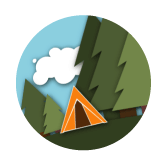Within all the excitement of planning a camping trip there are many practical things to consider. Checking the tent and equipment in advance, but one thing that sometimes gets overlooked is the need to have a well stocked first aid kit. It’s probably something you don’t consider until it’s a little too late.
There are always the opportunity for small cuts, grazes, and scratches when walking through thorn bushes; blisters; small burns when cooking around a stove or campfires; more adventurous activities like mountain biking, etc; exposing ourselves to the elements, wind, rain and sun; and insect bites are just a few examples of the ‘perils’ of outdoor activities that immediately spring to mind. So it will pay to think of what activities you plan to do and be prepared!
The well-stocked first aid kit may contain any of the following:
– Wound dressings:
– Assorted plasters
– Sterile gauze in rolls and pads
– Elastic bandages for wrapping sprains
– Strong tape (either a medical tape or small roll of duct tape)
– Blister treatment pads
– Adhesive wound-closure strips
– Antiseptic cream
– Antiseptic wipes and rinse solutions
– Sterile eye wash
– Pain relief medicine (paracetamol, ibuprofen, etc)
– Allergy medication, including antihistamines
– Sunburn relief spray
– Insect bite cream
– Anti-diarrhea medicine
– Splinter (fine-point) tweezers
– Scissors
– Safety pins
– Sterile gloves (nitrile preferred; avoid latex)
– Hand sanitizing gel
– Magnifying glass
– Digital thermometer
– Small torch or headlamp
– Thermal blanket
– Steel sewing needle with heavy-duty thread
– Glucose or other sugar to treat hypoglycemia
– Cold/flu relief tablets/sachets
– Antacid tablets
– Throat lozenges
– Lubricating eye drops
– First aid booklet/manual or information cards
Prevention rather than cure, also handy to include a
– Sun protection
– Mosquito/insect repellant
– Lip balm
– Water treatment tablets
This list is extensive, but by no means exhaustive. It is a guide to what you may need to consider. It is your responsibility to ensure you have the correct items in your first aid kit for the circumstances you may take.
Ignore kits that contain little more than a couple of plasters, a safety pin and a handful of painkillers (these really do exist), but then again, don’t be fooled by the quantity of components either. There are some very good pre-packaged first aid kits out there, but the best first aid kit is one where the contents are in-line with the risks you are likely to face. Make sure you have the basic categories covered – antiseptics, injury treatment, bandages and basic instruments. So check the contents and make sure you have what you need and if you think an item is missing purchase it separately and add it to your kit.
The reasoning behind most of this list should be fairly self evident. Cuts and grazes should be treated with antiseptic wipes or cream, include a variety of bandages, and you could also have some cotton buds on hand which might be useful for cleaning small wounds and applying antiseptic.
Tweezers for removing splinters and thorns, and scissors to cut tape and bandages.
Hand sanitizing gel to clean your hands before administering first aid
Keeping a dedicated emergency headlamp or small windup torch with the kit, will prove extremely useful if you ever need to administer at night or in the dark.
If you purchase a prepackaged first aid kit, most come with a First Aid Guidance Leaflet, if you compile your own it might be worth including some basic guidance or instructions. You may know first aid, but it may not be you who uses the kit in the future.
Also, consider how to pack your kit so you can access the items you need, in the order you might need them. Consider a modular approach, have a small personal cut and blister kit in a small resealable bag that you can carry with you at all times.
Keep the kit in a watertight container, most over the counter firt-aid kits come in a waterproof rip-stop bag. Consider a rigid air-tight plastic container, or if you are backpacking a plastic tub may not fit into your pack so a large resealable plastic bag could be used.
If you go out walking for the day, remember to take the first aid kit with you (or at least a personal first aid kit).
Ensure it’s easy to recognise and find, and that members of your party know it’s location. Keep it out of children’s reach too.
REMEMBER – to restock any items that are used during you camping trips away, and be sure to check your first aid kit regularly (annually at least) and replenish any exhausted and replace outdated medicines and supplies.
It doesn’t cost much, but it could save a life and will almost certainly ease someone’s pain at some point.
Search for Camping First Aid Kits






Pingback: Camping Safety - Camping and Outdoor Living